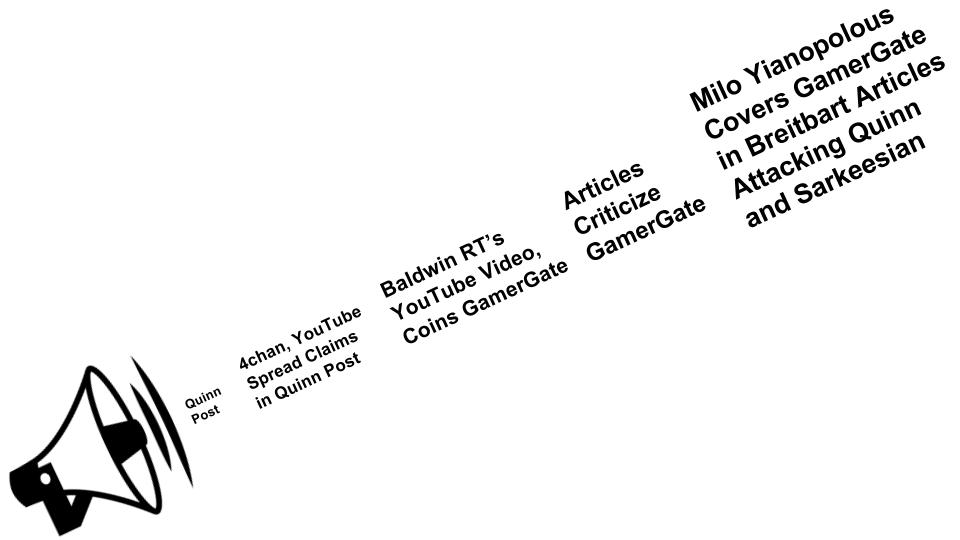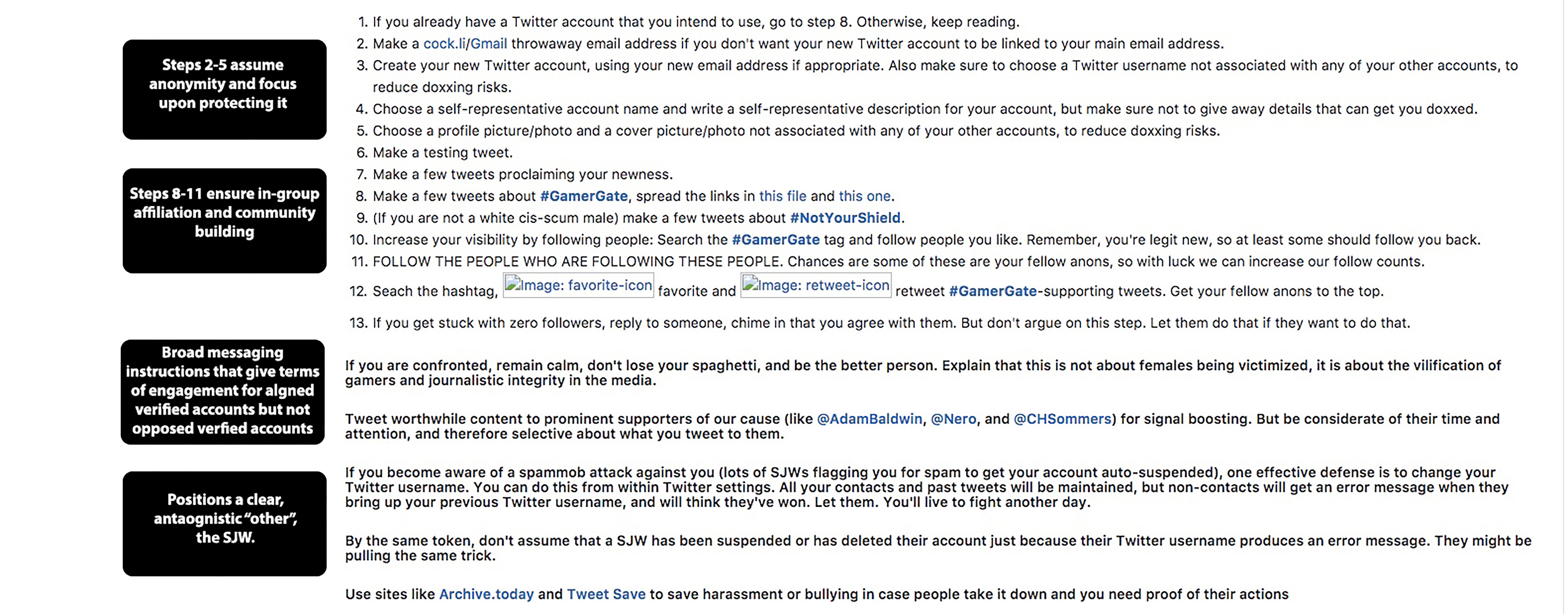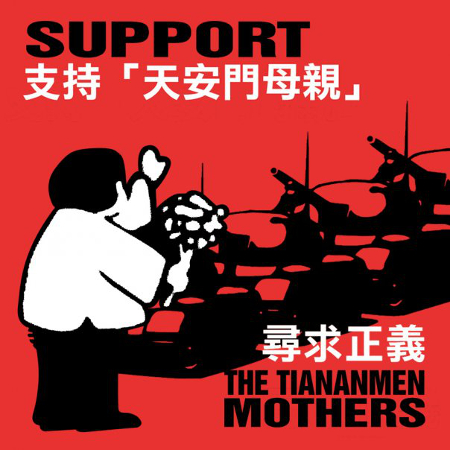Building Dark Patterns into Platforms: How GamerGate Perturbed Twitter’s User Experience
In this article, we examine how GamerGate trapped both its unwilling targets and willing participants in an unending cycle of rhetorical invention through a mechanism of aggressive, hostile, mob-like activism (Ames 48; Massanari 334; Mortensen 4-5). Influential elements within GamerGate, we argue, specifically subverted the functionality of Twitter as a corporate media platform in order to test a variety of loosely connected arguments to see what would resonate within whatever aggrieved audience the GamerGate collective could find. We have selected GamerGate specifically due to the manner in which the activists subverted the use of Twitter, GitHub, and other online services. In fact, we argue that GamerGate subverted media platforms like Twitter, GitHub, Reddit, and others to become components within an activist supraplatform, a system of interconnected platforms where the higher level platform reshapes the rhetorical purpose and context of the component parts. It is the higher level abstraction of GamerGate as activist supraplatform across multiple media platforms that this article will focus upon.
GamerGate employed tactics that were aggressive and offensive enough to be banned from controversial online forums. However, their removal from these spaces did little to stop GamerGate. Twitter did not ban the group, and this space offers a means to evaluate how the aggressive tactics manifested within GamerGate as an activist supraplatform compromised Twitter as a media platform—turning Twitter into a testbed of inventio for a range of argumentation. Their argumentation was directed at a trapped, targeted audience and designed to gather attention and amplify whatever arguments gathered the most attention for a growing anonymous mob. By examining GamerGate tweets and looking at in-group documentation, this article explains how activist supraplatforms, like GamerGate, can use the functional contradictions within media platforms to subvert the user experience within these sites. For the purpose of this article, we refer to participatory media sites as media platforms, including social media, messageboards, and other collaborative spaces.
GamerGate’s anarchic governance and contorted origins offers a compelling case study in online rhetorical invention. GamerGate itself began as a group of 4chan members spreading gossip about game designer Zoë Quinn that had been posted by an ex-partner. Dramatic and unsupported accusations of infidelity and sex for favorable game coverage spread across internet fora. While the initial group spreading the innuendo used numerous hashtags on Twitter, it was not until a celebrity amplifier—actor Adam Baldwin—retweeted a YouTube video about Quinn with the hashtag #GamerGate that the movement truly took off. Baldwin’s tweet not only reached his enormous Twitter follower base, but spawned news coverage about the actor becoming involved in the rumors about Quinn. Over the next month, a cycle of myriad accusations against various women, such as Quinn and Anita Sarkessian, would be followed by celebrity amplification from Baldwin to conservative author Christina Hoff Sommers to alt-right media personality Milo Yiannopoulos.
Each event would become its own happening, serving to fuel the cycle of news-promotion-discussion again and again without any move toward resolution nor any expression of achievable goals or end game. Over time, this cycle of accusation and amplification (Figure 1) would result in a noisy hashtag where dozens of targets and claims of purpose existed: anti-feminism, media criticism, personal vendetta, and opposition to any number of progressive policies and beliefs that might feed the accusation-amplification model. In this way, GamerGate existed in a perpetual state of invention, spinning off argument after argument with no interest in selecting a consensus cause other than maintaining its amplified, aggressive, combative, and noisy existence.

In this article, we present a framework to evaluate how activist supraplatforms, like GamerGate, interact with corporate social media platforms, like Twitter. We do this to examine how these activist supraplatforms can subvert media platforms and to examine how such subversions affect user experience within both the activist and media platform. We outline this subversion as a form of dark pattern, a term known in the software industry to describe design patterns that serve to trick users into performing certain tasks, often to their own detriment. In doing so, we offer a new means to evaluate rhetorical invention in both types of platforms as they disrupt or support these digital spaces, providing new methods for software designers and policy makers to address these issues and academic researchers to continue this scholarship.
Politics and Platforms
Scholars have long warned of the innovative dangers associated with dominant social platforms like Facebook, YouTube, and Twitter. Jonathan Zittrain (124-5) highlights the possibility that over reliance on dominant APIs controlled by corporations, who can change or pull them at any time, would restrict and limit the generative nature of the Internet. Stephen Coleman and Jay Blumler (170) likewise warn that current digital platforms lacked a required governmental responsiveness to public deliberation needed for healthy political engagement. Tarleton Gillespie (358) provides a rhetorical frame to criticize the closing of innovation outside of large corporate platforms by delving into the way these structures consumed the very (and varied) meaning of “platform” with the word’s intended and applied uses to claim traits like egalitarian and public for these corporate spaces. Twitter itself became a mix of media platform and political platform by tying its operational purpose to the Arab Spring and other political events, conflating its space as a microblogging hangout with that of real-world activism. In February of 2017, Twitter’s CEO, Jack Dorsey, made this conflation explicit when discussing the U.S. 2016 election: “A lot of the same patterns we’ve seen during the Iranian Green Revolution and the Arab Spring. It was stunning to see how Twitter was being used to have a conversation about the government, with the government” (Roberts). The idealized view Twitter’s CEO held of its media platform would leave unsuspecting users just as open to Russian manipulation in 2016 as it did other users to GamerGate’s manipulation in 2014.
Twitter enables this confusion with the juxtaposition of verified celebrity and journalist user accounts with a much larger anonymous public, one that would create dramatic tension between the two classes of users during GamerGate’s height. Whereas in previous cases, verified accounts had allowed anonymous sources to approach trusted agents, now it ensured that anonymous users had confirmed media and celebrity targets. Suddenly the functionality that allowed some to speak truth to power in the Arab Spring, and later #BlackLivesMatter, would subject little known gaming journalists to the prolific anger of thousands of aggrieved and loosely organized user accounts.
In fact, many users have demonstrated a clear ability to apply Richard Lanham’s (22) concept of oscillation to move back and forth between the content “fluff” of a single message and computational “stuff” of a powerful network of thousands of participants creating and echoing an array of content at selected targets. This rhetorical manipulation of computational context has been shown to create different experiences depending on participant usage (341). In a similar vein, Zeynep Tufekci (850) outlines how “microcelebrity” within platforms opened new avenues for activism. Microcelebrity, the ability of a noninstitutional activist to build an online following around a particular issue as a nexus node within (and across) a platform, highlights how users have begun to build activist supraplatforms within corporate media platforms through sophisticated understanding that allows a manipulation of network and computational functionality to achieve a specific messaging goal. Namely, it allows a highly visible node, like a microcelebrity, to serve as an organizational tool for the activist supraplatform by providing a means to create an event through focused targeting. What GamerGate discovered is that an activist supraplatform can create an unwilling microcelebrity with similar organizing effect, such as Quinn.
Dark Patterns of Activism
When a group attempts to attach an activist supraplatform to a media platform, a key ethical question arises in how the choice of participation is articulated within the user experience. The nature of this choice comes in two parts: 1) is the user experience forced or optional, and 2) do those who choose to engage understand the nature of the new user experience for themselves and others?
In the case of GamerGate the answer to the first question is simple but multifold. Many people chose to join the GamerGate activist supraplatform while highly significant numbers of people were forced targets of interaction. In 2014, thousands of people joined together on Twitter (and other media platforms) purportedly to express anger about numerous issues related to game critics and journalists. The supraplatform raised by these individuals, however, frequently targeted individuals in deeply personal and aggressive ways (Massanari 334) on Twitter rather than abiding by professional criticism of journalists and publishers. Many of the largest targets were women and they were frequently targeted for gendered reasons: sexuality, appearance, and legitimacy of expertise.
We know many chose to join the GamerGate network based upon our own findings of community-building tweets within our sample, as well as larger sampled studies using machine reading techniques (Chatzakou, et al.). Yet, many were forced to join the network. For example, many public feminists, journalists, and other Twitter users found themselves the unsuspecting targets of GamerGate’s mob-like platform (Massanari 330). These targeted participants of Twitter as a media platform had no choice about their interaction within the GamerGate activist supraplatform—other than to leave the many media platforms brought under the activist supraplatform’s umbrella. This inability to escape the GamerGate campaign was not least because Twitter was slow to address the disparate needs of activist users, journalist users, and casual users. It had conflated its role as a media platform with that of an political activism, leaving the public and verified journalists on the platform at a distinct disadvantage in trying to protect their reputations from mobs of anonymous accounts facing little to no consequence for their behavior.
Likely, most who participated in GamerGate felt they understood the nature of the experience. However, GamerGate as a platform was designed for a specific type of experience and it is worth examining if GamerGate employed ethical principles in relation to all involved. Returning to Lanham, we might ask if GamerGate suggested a design that allowed participants to see the rhetorical structure of the network as well as the message of the system. Or do we view some in GamerGate as we view hyperpartisan Twitter participants sharing Russian propaganda? Clearly aware of their own personal goals, but unaware of the manipulation of the media platform’s functionality for an alternative purpose. One way to review whether users were informed is to look for the possibility of dark patterns in GamerGate’s activist supraplatform.
Dark patterns are defined as a user experience crafted to trick the user into performing actions not in the user’s own interest (Brignull). Experts have looked at dark patterns in relationship to user interface (Brignull), physical proximity (Greenberg et al. 2), and social capital (Lewis 119). Among the many types of social and system interface dark patterns, three are of particular interest to us from Bringull and Grenberg: A) Bait and Switch: the promise of one experience that provides another; B) Captive Audience: the user enters a system expecting one type of platform (Twitter) and becomes subjugated to another (GamerGate); and C) Misdirection: the participant is encouraged to focused on one action to hide the existence of another less preferable activity.
Thus to see if the GamerGate platform utilized dark patterns to restrict its participants understanding of their user experience, we must look for areas where the GamerGate activist supraplatform restricted users from understanding elements of the broader Twitter media platform. Additionally, we must consider where the design put GamerGate’s best interest ahead of the participants.
Illustrating a Path of Rhetorical Invention By Disrupting Twitter
To understand how activism is motivated in the context of GamerGate, it is important to see the activist supraplatform as one designed beyond the wall gardens of a single site (Potts 23). Rather than relying on any one application, GamerGate uses Twitter, Reddit, 4/8chan, YouTube and a host of auxiliary tools for specific functionality and to achieve specific purposes, from instructive (Trice 2) to broadcasting (Burgess and Matamoros-Fernández 80). Additionally, the sense of community around the activism works both within and beyond the site itself (Mortensen 11).
What unites this process is a system of knowledge bases and social rules across GamerGate aimed at their participants. These rules are frequently replicated across media appearing in forums, Reddit, and archiving systems like GitGud, a GitHub clone using GitLab.

Moreover, within GitGud, GamerGate also has the supraplatform’s view of goals and outcomes clearly stated:
Our goal is simple: game devs should feel free to make what they like, no matter who finds it offensive or what stories they decide to tell, and we should feel free to purchase their work, or NOT purchase their work, based on whether we think it’s worthwhile, or according to OUR individual senses of what is or is not offensive or artistic. The gaming media should only serve as a method of helping to inform that decision, NOT shape it according to someone else’s politics, or determine what is or is not “acceptable” for release. Until these conditions are realized, and until there is a CLEAR, UNCONDITIONAL, AND IRREVERSIBLE admission of wrongdoing on the part of our opposition, negotiation is pointless. If there’s no admission of error, it’s exactly like a corporation paying off a litigant without admitting wrongdoing and then continuing their objectionable behaviour: nothing will change. There must be a recognition on the part of our opposition (or at least the community at large) that our opposition is in the wrong. Period.
Within this goal statement rests the core need for constant invention on the part of GamerGate. The purpose is not some set policy outcome or achievable condition, but rather the unconditional defeat and apology from an ever-growing list of enemies for behavior that is almost omnipotent as described above. The combination of anonymity attached to goals framed as unending war ensure a system that moves from argumentation and achievable goals to endless rants and harassment for all involved.
A Closer Look at GamerGate as Dark Pattern
After examining the instructional framework behind GamerGate’s Twitter activity, we looked at 100 tweets from November of 2014 to determine what type of activities we might categorize within the tweets. Our goal was not to create the definitive list of categories, but simply to examine a selection of activities performed within the hashtag.2
In general, we noted three main activities (Table 1): instructional/operational (21 tweets), critical (38), and community building (22). We also noted some lesser categories of appealing to microcelebrities (9) and spreading news (6). However, we opted to focus on the larger three categories due to their clear dominance in our sample.
These three distinct types of activity largely involved:
- Providing strategic operational instruction that served to close stasis of definition, describe tactical information, and establish a history of the GamerGate movement.
- Criticizing some group, typically referred to as feminists, social justice warriors,3 journalists/media, or some specific agent.
- Building an internal community narrative through cultural artifacts and morale boosts.
Table 1. Categories of GamerGate Tweets
| Category of Tweet | Tweets | Definition |
| Instructional/Operational | 21 | Discussion of tactics or functional elements, link including links in tweets. |
| Critical | 38 | Criticism of a group or individual. |
| Community Building | 22 | Social interactions, creative gestures, and morale boosting. |
In our sample, the most criticized topic was GamerGate itself. So while many targets of GamerGate were forced into interaction, many critical of GamerGate opted to engage by choice. Secondly, those in GamerGate were critical of a wider variety of topics, not focused on a single issue. GamerGate directed its criticism at groups it named as specific individuals, critics of GamerGate, and the media. This split focus within the hashtag points toward how misdirection and captured audience appeals worked to complicate any stasis of definition within the hashtag, maintaining an extended period of invention. Essentially, GamerGate offered a noise machine pointed at a number of named but under-defined target groups. Members of GamerGate with any grievance for one were encouraged to support its grievance against all, no matter how poorly defined a target group might be.
Operationally, the platform engaged in a robust discussion of tactics and history. These tweets leave little doubt that GamerGate saw itself as a platform built for active engagement with some other. Additionally, community building was robust and diverse in nature, including creation of artifacts like music videos, and memes without tactical value beyond community building. GamerGate’s use of operational and community-building tweets reflect a platform with a clear us (GamerGate) versus them (feminists, critics, the media) nature.
In all, our sample of GamerGate tweets echoed the GitGud Twitter instructions closely. It was mostly critical in nature, though unfocused on a single position or topic. Yet it also demonstrated a tightly connected community concerned with keeping spirits high and interacting with others in the hashtag. In fact, the tonal binary of in-group versus out-group from the Twitter instructions was the most consistent element of our sample. This, too, suggested a specific dark pattern within the GamerGate platform: instituting an us-versus-them environment from the outset. The targets of GamerGate quickly become a captive audience in GamerGate’s activist supraplatform with little choice to exit the GamerGate experience short of leaving Twitter. The hostility also created a bait and switch scenario for any in GamerGate who expected productive activism and engagement as the complete lack of consensus making tools within GamerGate kept the activism within a perpetual stage of invention, constantly churning loosely related arguments with no capacity for resolution. Perhaps one of the most important dark patterns within GamerGate then became how the platform was created for chaos and disinformation while claiming to its members that it could somehow create productive change.
The Give and Take of Rhetorical Invention in Public Platforms
In the end, GamerGate activism resembles a churn of constant invention, moving from one celebrity to another, whether as friend or foe (Figure 1). Rather than possessing a single, authoritative argument, GamerGate welcomed whatever argument caught fire (criticism of Quinn, feminists, SJWs, games journalists, or each other). This activism platform neglected a means toward finding consensus of outcome in favor of expanding its volume of tweets and RTs while promoting anonymity amongst its participants. Importantly, this defense of anonymity was promoted with fear appeals of doxing juxtaposed against GamerGate’s willingness to target verified accounts and centralize around friendly celebrities.
The use of dark patterns in GamerGate drove its success. For its targets, GamerGate took advantage of its numbers to turn the Twitter experience into an inescapable GamerGate experience. When one member sent a message, that message became a signal to highly connected community that had been instructed to echo one another and to target a wide, loosely defined array of others. For its members, it sold fear and anonymity as identity, lessening any opportunity for legitimacy or accountability because it denied any attempt at establishing goals and removed the possibility of personal identity to offer personal accountability. This inability for GamerGate to oscillate between what was effective signal boosting and what was effective argumentation generated the environment of harassment GamerGate became known for. Its ever-expanding list of targets and arguments also prevented any opportunity for moving beyond invention toward some form of outcome or realized argument beyond mob-like aggression. While this likely was intentional for many participants within GamerGate, the absence of any mechanic to resolve and justify its existence clearly separates GamerGate from mission-based activism of other Twitter activism, including the Arab Spring, Black Lives Matter, and MAGA.
None of this is to excuse those who participated in GamerGate. Its use of unethical dark patterns were clearly more harmful to its targets than its participants. Its participants also had the opportunity to recognize the structure of the activist supraplatform for what it was. However, Lanham did not highlight oscillation in his research because it was easy or innate. Recognizing how dark patterns can exasperate harassment and prolong mob-like activity is important for rhetoricians and for digital design. Spaces like Twitter must make clear-headed choices about how conflation of platform purpose and user experience makes them vulnerable to abuse and potentially undermines their goals as both a media platform and an activist supraplatform.
Endnotes
- Doxxing is the making public of someone’s private information online with the intent to harass the target. return
- We selected a 24-hour period in November to sample tweets. This period was at the height of the GamerGate cycle and thus sufficiently removed from the initial origins so as to more fully represent the spread of messaging. We chose tweets from this period with the GamerGate hashtag and randomly sampled 100 tweets. We opted to evaluate only tweets and not retweets to reduce the role of contextual and conversational confusion in our coding process. return
- Social justice warrior or SJW in this use is a pejorative term for someone who openly discusses social justice issues online. return
Works Cited
- Ames, Kate. “Gamergate, fragmentary storytelling, and news narrative: Convergence, ‘conversation’, and context in journalism education.” Journalism Education, vol. 5, no. 2, 2016, pp. 46-58.
- Bringull, Harry. Darkpatterns.org. 18 June 2017.
- Burgess, Jean, and Ariadna Matamoros-Fernández. “Mapping Sociocultural Controversies across Digital Media Platforms: One Week of #Gamergate on Twitter, YouTube, and Tumblr.” Communication Research and Practice, vol. 2, no.1, 2016, pp. 79-96.
- Chatzakou, Despoina, et al. “Measuring# GamerGate: A Tale of Hate, Sexism, and Bullying.” Proceedings of the 26th International Conference on World Wide Web Companion. International World Wide Web Conferences Steering Committee, 2017.
- Coleman, Stephen, and Jay G. Blumler. The Internet and Democratic Citizenship: Theory, Practice and Policy. Cambridge UP, 2009.
- Gillespie, Tarleton. “The Politics of ‘Platforms’.” New Media & Society, vol. 12, no. 3, 2010, pp. 347-364.
- Greenberg, Saul, et al. “Dark Patterns in Proxemic Interactions: A Critical Perspective.” Proceedings of the 2014 Conference on Designing Interactive Systems. ACM, 2014.
- Lanham, Richard A. The Economics of Attention: Style and Substance in the Age of Information. U of Chicago P, 2006.
- Lewis, Chris. “Understanding Motivational Dark Patterns.” Irresistible Apps. Apress, 2014. 99-102.
- Massanari, Adrienne. “#Gamergate and The Fappening: How Reddit’s Algorithm, Governance, and Culture Support Toxic Technocultures.” New Media & Society, vol. 19, no. 3., 2017, pp. 329-346.
- Mortensen, Torill Elvira. “Anger, Fear, and Games: The Long Event of #GamerGate.” Games and Culture, 2016, pp. 1-20. 1555412016640408.
- Potts, Liza. Social Media in Disaster Response: How Experience Architects Can Build for Participation. Routledge, 2014.
- Potts, Liza, and Dave Jones. “Contextualizing Experiences: Tracing the Relationships between People and Technologies in the Social Web.” Journal of Business and Technical Communication, vol. 25, no. 3, 2011, pp. 338-358.
- Roberts, Jeff John. “Twitter’s CEO Says It’s Having an ‘Arab Spring’ Moment in the U.S.” Fortune 16 Feb. 2017. http://fortune.com/2017/02/15/twitter-jack-dorsey-arab-spring/
- Trice, Michael. “Putting GamerGate in context: how group documentation informs social media activity.” Proceedings of the 33rd Annual International Conference on the Design of Communication. ACM, 2015.
- Tufekci, Zeynep. ““Not This One” Social Movements, the Attention Economy, and Microcelebrity Networked Activism.” American Behavioral Scientist, vol. 57, no. 7, 2013, pp. 848-870.
- Zittrain, Jonathan. The Future of the Internet—And How to Stop It. Yale UP, 2008.




 Michael Trice is a Lecturer in Writing, Rhetoric, and Professional Communication at the Massachusetts Institute of Technology. He teaches writing and communication across the curriculum, with a focus in computer science and mechanical engineering. His past research projects have examined how participant experience levels inform user experience in community media platforms, how crowd-sourced instruction rhetorically frames online activism, and how reasoning can be visualized in scientific discourses.
Michael Trice is a Lecturer in Writing, Rhetoric, and Professional Communication at the Massachusetts Institute of Technology. He teaches writing and communication across the curriculum, with a focus in computer science and mechanical engineering. His past research projects have examined how participant experience levels inform user experience in community media platforms, how crowd-sourced instruction rhetorically frames online activism, and how reasoning can be visualized in scientific discourses.  Liza Potts is an Associate Professor in the
Liza Potts is an Associate Professor in the